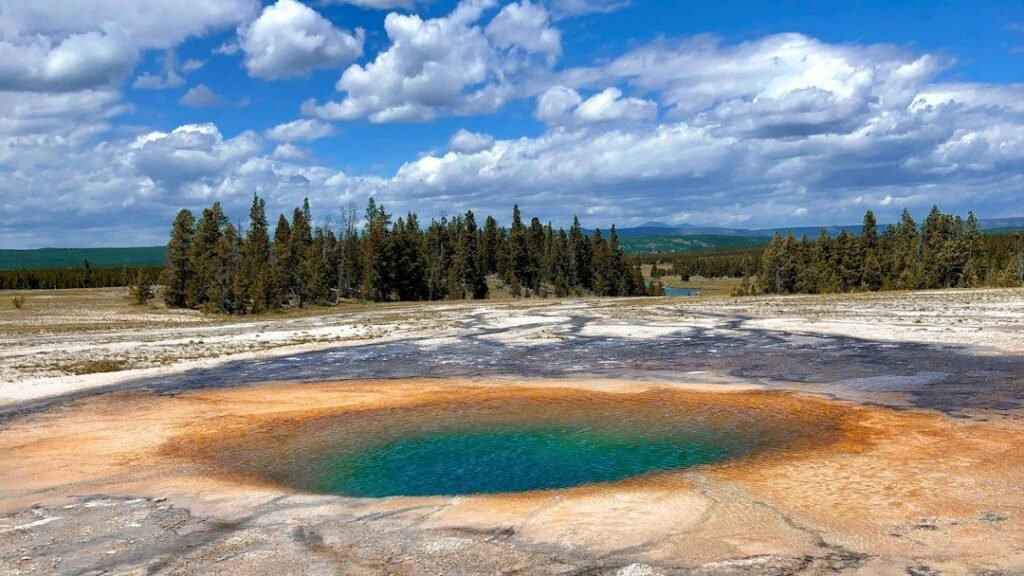Beneath the surface of America’s most famous geysers lies a hidden world of chemical reactions more complex than most science labs. These thermal wonderlands aren’t just pretty water shows. They’re natural laboratories where ancient rocks meet superheated water, creating chemical cocktails that would seem impossible if they weren’t happening right before our eyes.
The United States boasts some of the most geochemically diverse geyser basins on Earth, each with its own signature chemistry that shapes everything from the colors we see to the minerals that build up over thousands of years. Get ready to discover the bizarre molecular secrets that make these natural phenomena so extraordinary.
Upper Geyser Basin: The Silica Wonderland
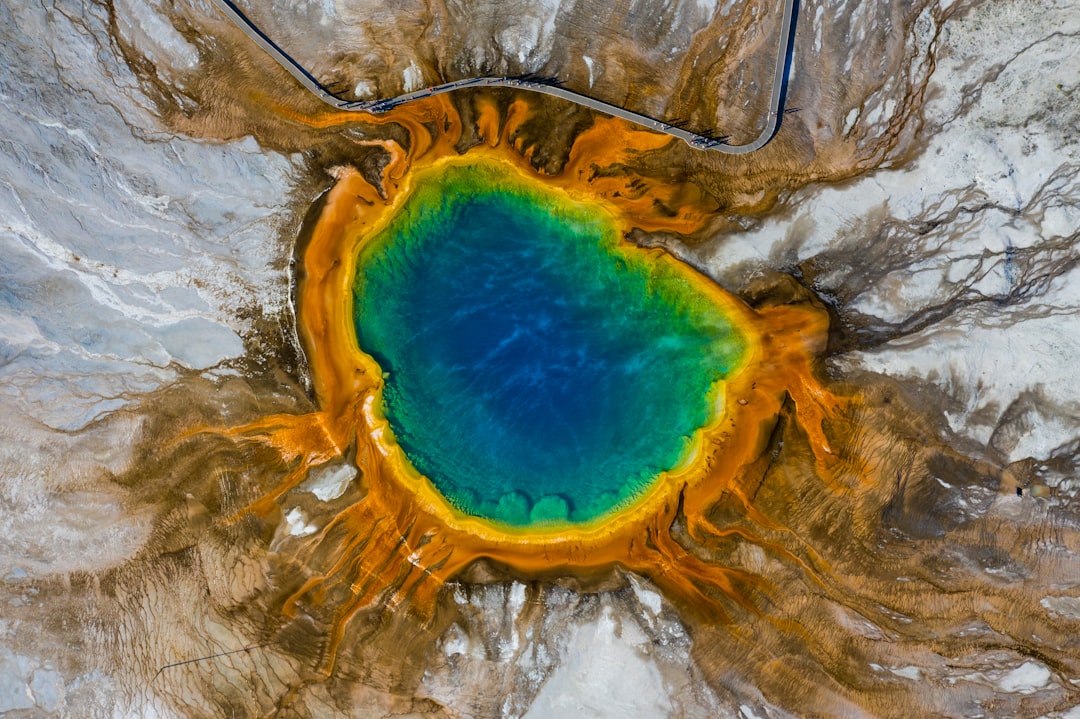
The Upper Geyser Basin in Yellowstone hosts approximately 150-180 of the world’s active geysers, but what makes it truly remarkable is its chemistry. At the surface, neutral-chloride springs often discharge significant of quantities water containing relatively high concentrations of carbonate, chloride, silica, and arsenic. These waters are common in Yellowstone’s famous geyser basins and create the iconic silica sinter deposits that define the landscape.
The neutral to alkaline waters that are common in the geyser basins typically contain up to 400 milligrams of silica in one liter of water (equal to about 0.1 teaspoons of silica in a quart of water). This dissolved silica comes from the rhyolite rock beneath, which contains roughly three-quarters silica. When the superheated water rises to the surface and cools, it transforms into the opal that builds the cone structures around famous geysers like Old Faithful.
The chemical journey doesn’t stop there. Sinter matures progressively from opal-A, opal-A/C, opal-A/CT, opal-CT, opal CT + quartz, and finally quartz. This transformation happens over thousands of years, creating a geological timeline written in mineral form.
Sinters are enriched in antimony, cesium, gallium and rare earth elements (REE). REE concentrations are 2–3 orders of magnitude higher than in thermal water. These trace elements concentrate in the deposits, creating chemical signatures that tell scientists about the deep underground processes.
Norris Geyser Basin: The Chemical Chameleon
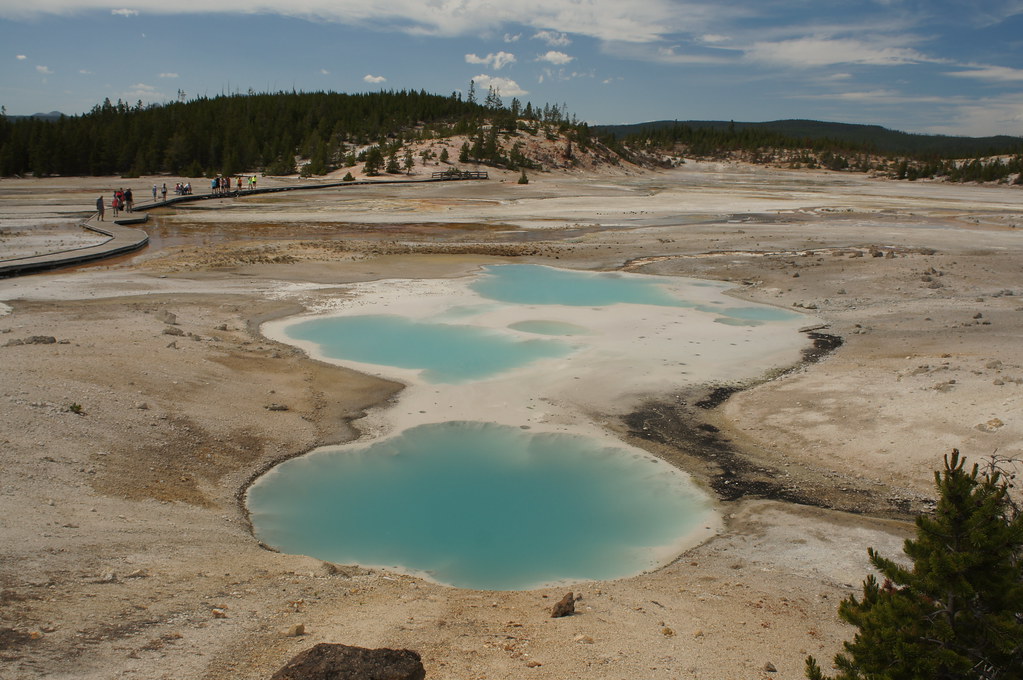
Norris has the greatest water chemistry diversity among Yellowstone’s hydrothermal areas. Multiple underground hot water reservoirs exist here and as their water levels fluctuate, concentrations of chloride, sulfate, iron, and arsenic change. This makes Norris a constantly shifting chemical landscape where springs can transform from clear to muddy overnight.
What sets Norris apart is its extreme temperature range and chemical variability. Norris Geyser Basin is the hottest on-land geyser basin within Yellowstone National Park, with a wide diversity of thermal feature chemistry and activity. Some features here reach near-boiling temperatures while maintaining incredibly diverse chemical compositions that would be impossible to replicate artificially.
100 Spring Plain is a flat, sandy plain that exhibits features with a wide variety of water chemistry, including some of the most unique features in Yellowstone National Park (i.e., acidic mud pots, neutral-chloride sinter depositing features, sulfate-dominated waters with spherules, and sulfur-precipitating springs). This single area contains almost every type of hydrothermal chemistry found anywhere on Earth.
The strangest feature might be Cinder Pool, where odd, dark-colored, frothy “cinders” that float on the surface of the pool. This oddity has fascinated scientists for over a century, and investigations revealed that the cinders are composed of sulfur that looks black due to tiny grains of pyrite.
Lower Geyser Basin: The Fluorite Factory
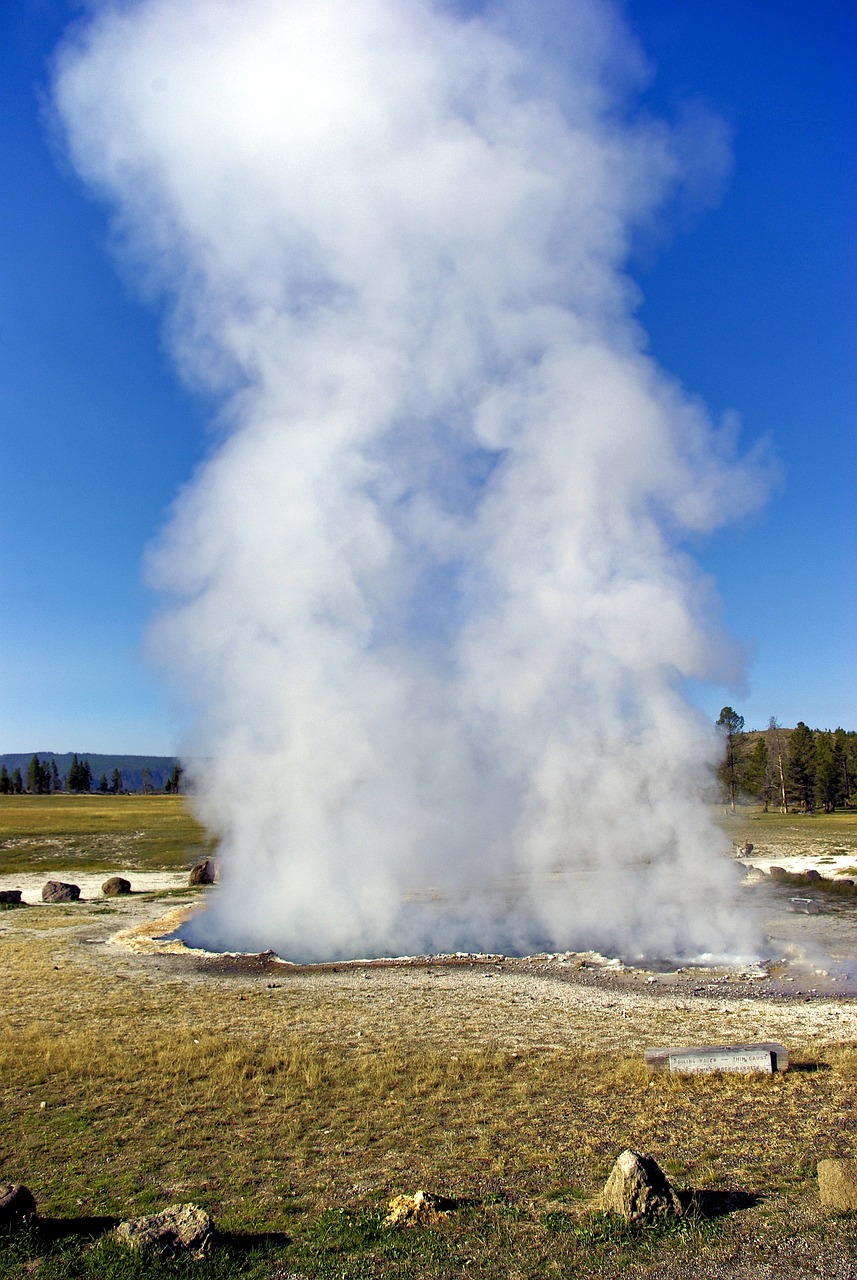
Lower Geyser Basin is the largest thermal basin in Yellowstone National Park (~12 km2 of actively hot area), but its chemical claim to fame involves an unusual mineral. Research into sediment cores from this basin revealed something extraordinary: massive deposits of fluorite, a mineral rarely found in lake sediments.
The orange sediment (left, scale in cm) consists mostly of fluorite, a common mineral in some hydrothermal deposits, but not usually found in lake sediments. This fluorite formation tells a story of ancient hydrothermal activity that was much more intense than what we see today.
The chemistry here also involves high concentrations of arsenic, creating a toxic but scientifically fascinating environment. Sediments also contain abundant arsenic, known to be concentrated in thermal waters, and deposits of fluorite, a mineral produced by hydrothermal activity. These chemical signatures paint a picture of Lower Geyser Basin’s evolution over thousands of years.
Scientists studying this basin discovered that Lower Geyser Basin was forested from 10,300 to 3,800 years ago, and that hydrothermal features were active near or within Goose Lake, showing how dramatically the chemistry and landscape have changed over geological time.
Mammoth Hot Springs: The Travertine Anomaly
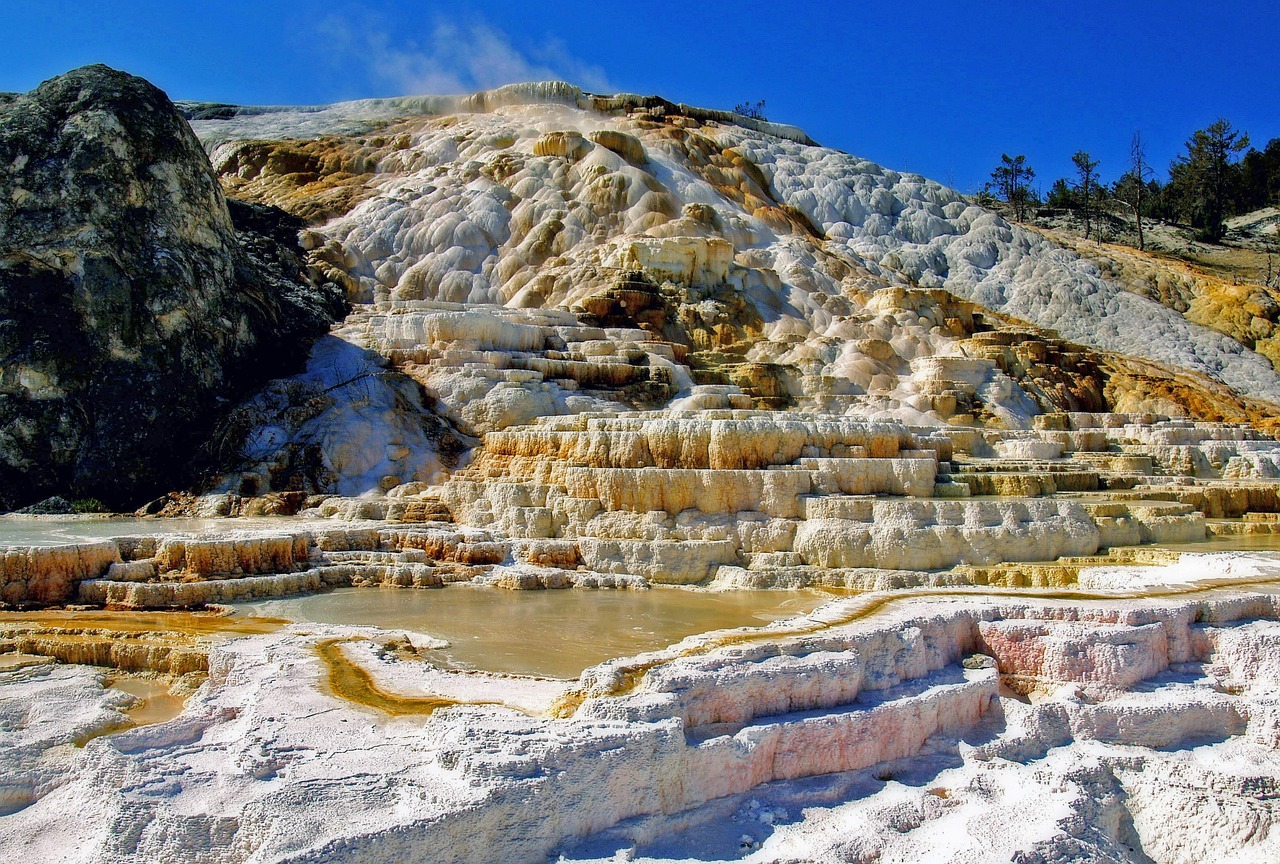
While most Yellowstone thermal features deposit silica, Mammoth Hot Springs creates something entirely different. Early explorers during the separate Washburn, Hayden, and Hague expeditions of the 1870s were astonished by the massive terraces and pools of hot-spring limestone, better known as travertine, at Mammoth Hot Springs – a chemical oddity that is quite different from other Yellowstone thermal areas.
Compared with alkaline-chloride waters, like those from Old Faithful, thermal waters at Mammoth Hot Springs are rich in calcium, magnesium, bicarbonate, and sulfate. This unique chemistry comes from water flowing through ancient limestone formations deep underground, picking up dissolved calcium carbonate along the way.
The transformation happens at the surface through a fascinating chemical process. When hot spring fluids emerge from the subsurface into the pools on Mammoth terrace, pressure release causes them to degas (like opening a can of soda), and this loss of carbon dioxide causes the pH to increase to about 8. This pH change triggers the precipitation of travertine.
It was created over thousands of years as hot water from the spring cooled and deposited calcium carbonate (substantial amounts of calcium carbonate flow into Mammoth each day in solution). Terrace Mountain at Mammoth Hot Springs is the largest known carbonate-depositing spring in the world.
Mud Volcano Area: The Acid Sulfate Cauldron

The Mud Volcano area represents one of the most chemically aggressive environments in North America. These waters are common in features in the Mud Volcano area, where acid-sulfate conditions create a landscape that looks more like an alien planet than Earth.
Acid sulfate waters are found throughout Yellowstone, particularly at higher elevations and at the Mud Volcano area. According to White, Sandberg, and Brannock (1953), acid sulfate waters may form where steam, rich in acid-forming gases, intersects near-surface groundwater. This process creates some of the most corrosive natural water on the continent.
The chemistry here is so extreme that it literally dissolves the surrounding rock. These features tend to be fumaroles, mud pots, or acid-sulfate boiling pools with little to no discharge. The landscape surrounding these features is frequently barren and composed primarily of clays and resilient quartz minerals.
However, dissolved silica polymerizes very slowly in the acid chloride water and little silica deposition occurs. This means that while other areas build up mineral deposits over time, the Mud Volcano area actually breaks down rock faster than it can rebuild, creating its characteristic desolate appearance.
West Thumb Geyser Basin: The Underwater Chemistry Lab

West Thumb Geyser Basin occupies a unique position at the edge of Yellowstone Lake, creating a rare combination of lacustrine and hydrothermal chemistry. This location allows for some of the most unusual chemical interactions found in any American geyser basin, where lake water mixes with rising thermal fluids to create hybrid compositions.
The underwater vents in this basin create chemical gradients that exist nowhere else in the continental United States. Hot, mineral-rich water rises from deep sources and encounters the relatively cool, dilute lake water, creating mixing zones with rapidly changing pH, temperature, and mineral content. These gradients support unique microbial communities that have adapted to constantly fluctuating chemical conditions.
What makes this basin chemically fascinating is how the lake water moderates the extreme chemistry typical of other thermal areas. The dilution effect creates milder conditions that allow for different mineral precipitation patterns and support biological processes that couldn’t survive in more concentrated thermal waters elsewhere in the park.
Scientists have observed that seasonal lake level changes dramatically affect the chemistry of thermal features here. When lake levels drop, thermal features become more concentrated and aggressive. When levels rise, the chemistry becomes more dilute and neutral, demonstrating how water chemistry can shift dramatically with environmental conditions.
Midway Geyser Basin: The Rainbow Chemistry
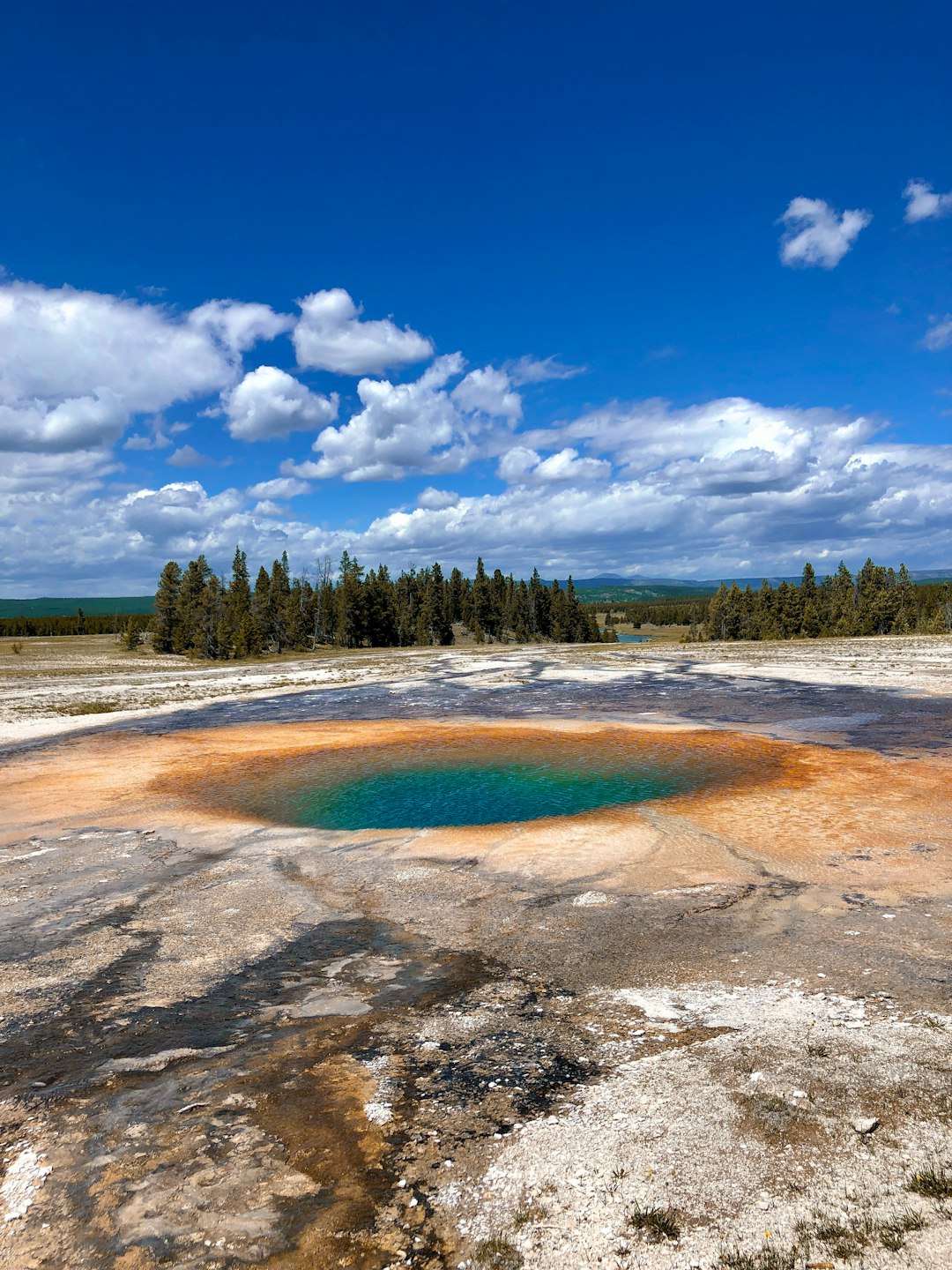
Midway Geyser Basin hosts some of the most visually spectacular chemical displays in North America, including the famous Grand Prismatic Spring. The rainbow colors that make this basin famous are actually chemical signatures created by different mineral compositions and microbial communities thriving at specific temperature and pH ranges.
The center of Grand Prismatic reaches temperatures too high for most life, creating the brilliant blue color of pure water with dissolved minerals. As the water flows outward and cools, different thermophilic bacteria and archaea establish colonies in concentric rings, each adapted to specific temperature ranges and chemical conditions. These microorganisms produce different pigments, creating the famous rainbow effect.
The chemistry here involves high concentrations of silica and chloride, similar to other major geyser basins, but the large size and shallow depth of the main pools create unique evaporation and concentration effects. This leads to mineral precipitation patterns and microbial zoning that creates the most photographed thermal feature in America.
What sets Midway apart chemically is the massive volume of water involved. The sheer scale of fluid circulation here creates chemical stability and temperature gradients that allow for the development of complex ecological zones impossible in smaller thermal features.
Shoshone Geyser Basin: The Quiet Giant’s Chemistry
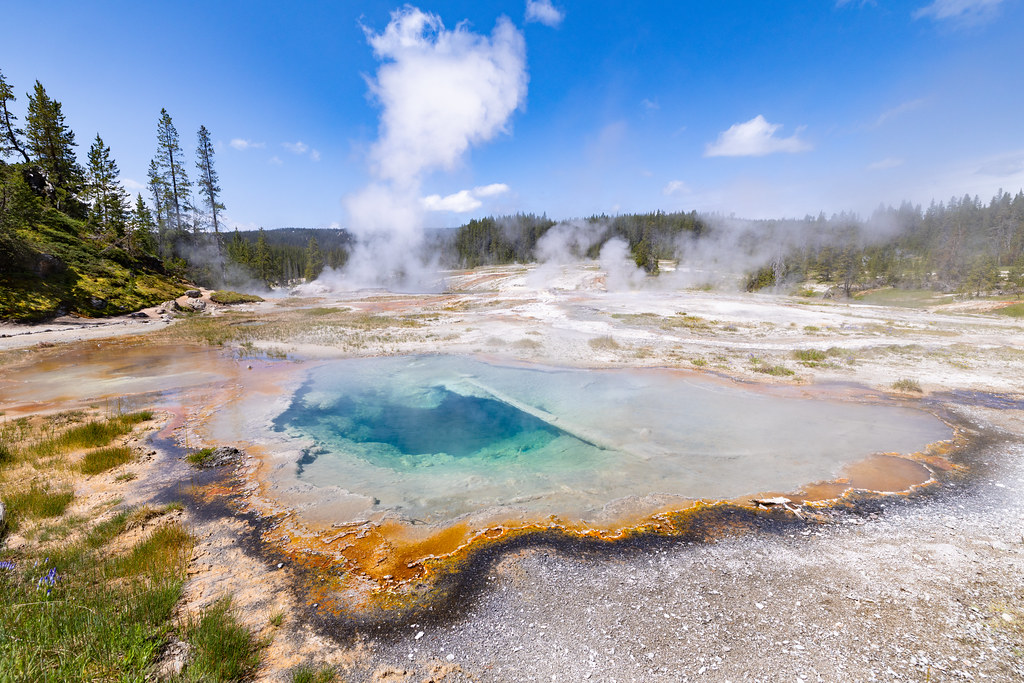
Shoshone Geyser Basin, located along the remote shores of Shoshone Lake, represents one of the most chemically pristine geyser basins in America. With no road access and minimal human impact, this basin provides insight into how thermal chemistry develops in truly natural conditions.
The isolation of this basin has allowed its chemistry to develop without the disturbances that affect more accessible areas. The thermal features here show classic neutral-chloride chemistry, similar to Old Faithful, but with subtle variations that suggest different deep-source contributions or slightly different flow paths through the underground rock formations.
Research in this basin has revealed how chemical stability develops over long periods without human interference. The consistent chemistry here contrasts sharply with the more variable conditions found in basins that experience regular human visitation, temperature monitoring, and research activities that can subtly influence thermal systems.
Scientists studying Shoshone Basin have found that its remote location allows for seasonal and long-term chemical variations that provide baselines for understanding how thermal chemistry responds to natural environmental changes versus human-induced alterations in more accessible locations.
Conclusion
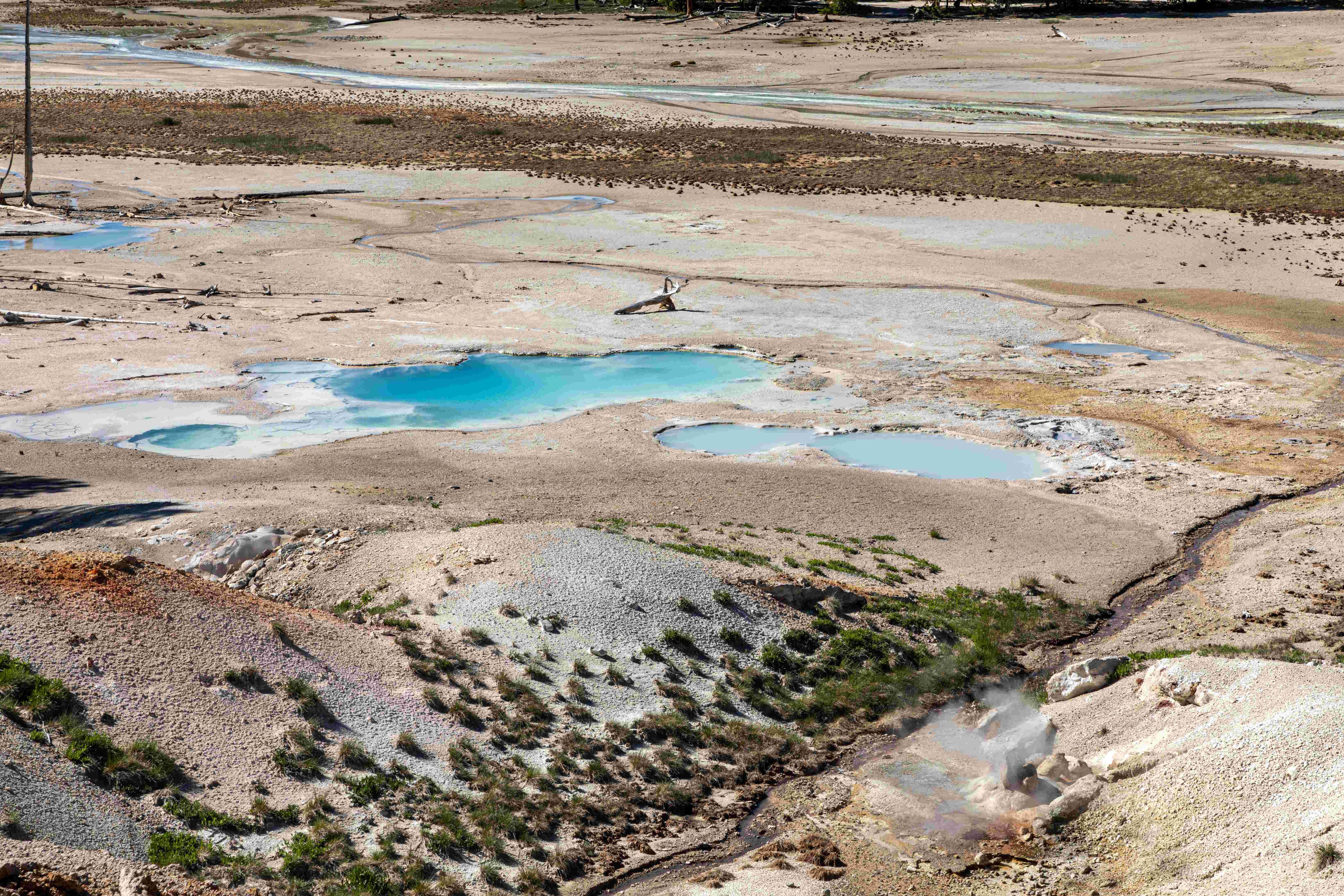
These eight American geyser basins represent some of the most chemically diverse and extreme environments on our planet. From the silica-rich waters of Upper Geyser Basin building massive sinter cones, to the acid-sulfate cauldrons of Mud Volcano dissolving solid rock, each location tells a unique chemical story written in minerals, microbes, and geological time.
The chemistry of these thermal features connects directly to deep geological processes, ancient rock formations, and ongoing volcanic activity beneath our feet. Understanding these chemical systems helps scientists predict how they might change over time and provides insights into similar processes that may have shaped early Earth or could exist on other planets. What fascinates you most about these hidden chemical worlds? Share your thoughts in the comments below.

